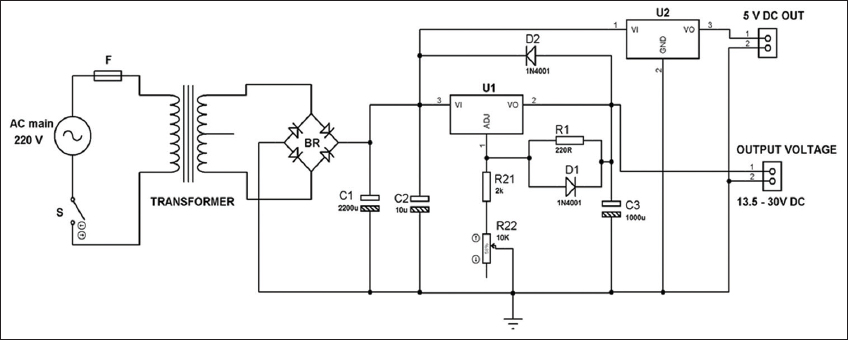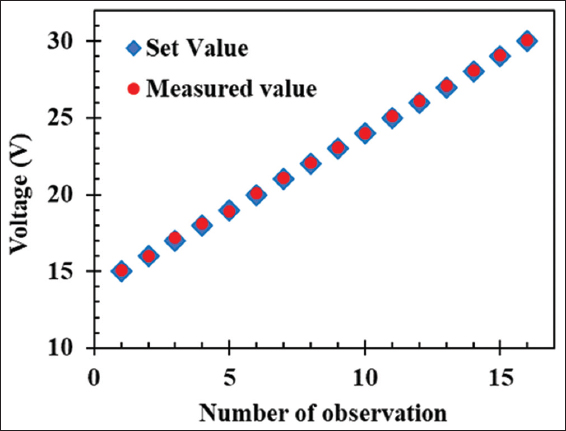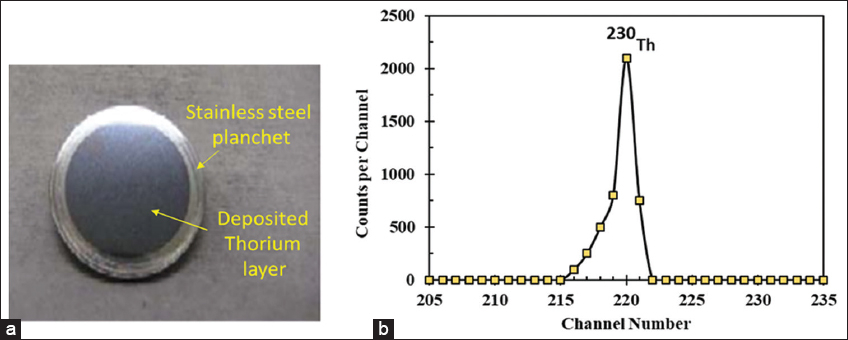INTRODUCTION
Alpha-spectrometry system (ASS) is a substantial analytical method for the detection of alpha particles in nuclear, environmental, and biological samples.[1-3] In general, the preparation of alpha source is a very important requirement for ASS to get the quality alpha spectrum. The surface of the alpha source should be smooth to reduce the loss of energy by the roughness of the backing surface. Various methods are involved in the preparation of alpha sources.[4,5] Among those methods, electrodeposition technique is considered as one of the commonly used methods for the preparation of alpha source from environmental samples, especially soil and biological objects.[6,7] In this technique, an alpha source is made by a radioactive sample deposited on a metallic substrate. The most common metallic substrate is used stainless steel, which performs as the cathode of the electrolytic cell. The fundamental of this technique is the deposition of a thin basic cathodic layer, where the power supply plays a significant role for electrodeposition.[8] For proper electrodeposition, it is essential to ensure specific voltage, current, and operating time for each sample. Thus, the design and development of a customized direct current (DC) power supply for the electrodeposition technique in ASS has appealed great attention.
Usually, a customized DC power supply is a device that supplies electric power to an electrical load, which allows the user to regulate the DC output voltage or current within the specified ranges. The voltage produced by an unregulated power supply will vary depending on the load and on variations in the alternating current (AC) supply voltage. For special electronic applications, a linear regulator may be used to set the voltage to a precise value, stabilized against fluctuations in input voltage and load. The used regulator also greatly reduces the ripple and noise in the output DC. These types of linear regulators often provide current limiting, protecting the power supply and attached circuit from over current. However, there are different types of regulated power supplies available in the market. However, they are not customized, as the power supply is designed for a specific application, it is expected to be flexible for use and maintenance.
Health physics division (HPD) of our institute, Atomic Energy Centre, Dhaka (AECD), is engaged to measure alpha particles, especially thorium (Th) of the environment samples such as soil and biological objects through ASS. Th can be easily extracted from various natural samples for ASS.[9] From the experimental point of view, this division suggests that for proper electrodeposition of Th in ASS, about the voltage of 25 V and current of about 80 mA are required. Considering these factors, a customized DC power supply has been developed to carry out electrodeposition experiments for ASS at HPD. The power supply has the flexibility to adjust the voltage from 13.5 to 31 V and current up to 1.5 A. The design, construction, and experimental results of the power supply are demonstrated in the following sections of this article.
MATERIALS AND METHODS
Design and Development of the Power Supply
In general, a DC power supply uses a transformer to convert the voltage from the wall outlet (mains) to lower voltage; a rectifier is used to convert alternating voltage to a pulsating direct voltage, followed by a filter, comprising one or more capacitors and resistors.[10] However, our designed DC power supply consists of three basic building blocks: (1) Power source unit (2) regulator unit, and (3) display unit, as shown in Figure 1.
Figure 1: Basic block diagram of the direct current power supply
The power source circuit includes AC main, a step-down transformer, a bridge rectifier (BR) with capacitive filter. The detail circuit is presented in Figure 2. Switch S and fuse F (1.5 A) is connected in series to AC main for safety purpose. Transformer is of one the main parts of the power supply used to step-down the mains AC voltage of 240 V to lower AC voltage of 24 V. The transformer output rating is 12–0–12 V and 2500 mA. The BR (2W04G) is the important part and plays a role to produce full-wave varying DC voltage. The output from the rectifier is pulsating DC that contains ripple. Capacitors C1 (2200 µF) and C2 (10 µF) connected in parallel act as a filter to reduce the ripple of waveforms and produce steady-state DC voltage.
Figure 2: Circuit diagram of the direct current power supply
Regulator unit mainly consists of a regulator integrated circuit (IC) U1 (LM317), which is an adjustable 3-terminal positive voltage regulator capable of supplying in excess of 1.5 A over an output voltage range of 1.2–37 V. The LM317 maintains a nominal 1.25 V reference voltage between its output and adjustment terminals. This reference voltage is converted to a programming current by R1, and this constant current flows through R2 to ground.
The regulated output voltage is given by:
Since Iadj is controlled to <100 µA, the error associated with this term is negligible in most applications.
The LM317 was designed to control Iadj to <100 μA and keep it constant. For the best performance, the programming resistor R1 (220 Ω) should be connected as close to the regulator as possible to minimize line drops which effectively appear in series with the reference, thereby degrading regulation. The ground end of R2 can be returned near the load ground to provide remote ground sensing and improve load regulation. R2 is the series combination of a fixed resistor R21 (2 kΩ) and a variable resistor R22 (10 kΩ) employed for producing a variable output voltage. Diode D1 (1N4007) prevents C3 from discharging through the regulator IC during an input short circuit. Diode D2 (1N4007) protects against capacitors C1 and C2 discharging through the regulator IC during an output short circuit. Further, to reduce the thermal consumption, heat sink is attached on LM317.
In the display unit, two 7-segment LED digital panel meters are used for showing voltage and current, respectively (not shown in the circuit diagram for simplicity). Each panel meter shows 4 digits, where decimal point position is set after the second digit. The panel meters are driven by positive 5 V, which is produced through a voltage regulator IC U2 (LM7805). Capacitor C4 (470 µF) is connected to the output of LM7805 as a current buffer for voltage regulation.
Experimental
Electrodeposition of soil samples has been carried out using this customized power supply. Its experimental setup and schematic diagram are demonstrated in Figure 3a and b, respectively. This experiment was performed to measure the presence of alpha-emitting radionuclide, Th in the soil samples. Accordingly, before electrodeposition, soil samples were prepared in such a way to produce Th solution. The details of the soil samples preparation are described elsewhere.[11]
Figure 3: (a) Photograph of experimental setup for electrodeposition, (b) schematic diagram of electrodeposition process, and (c) photograph of alpha-spectrometry system for the period of investigation of the electrodeposited sample
The electrodeposition chamber is a hollow cylinder made of polystyrene with 2 cm in internal diameter and 10 cm in length. A platinum rod suspended centrally in the chamber acts as an anode. Stainless steel planchet with a diameter of 2.5 cm was used as the cathode for electrodeposition. Th solution was put into the deposition chamber, and its volume was reduced to 25 mL through heating. After cooling, 2 mL of methanol was added to enhance the viscosity of the Th solution. The distance between anode and cathode was kept 1 cm. A voltage of 25 V from the developed DC power supply was applied between the anode and cathode, where the current consumption was about 80 mA. A digital multimeter was used to measure the voltage and current during the experiments. The deposited samples were examined by the ASS [Figure 3c], where the electrodeposited planchet was placed 1 cm below from a silicon surface barrier detector fitted in a standard vacuum chamber coupled with a multichannel analyzer and associated electronics for alpha counting.
RESULTS AND DISCUSSION
A laboratory level prototype of customized DC power supply has been fabricated, which shows the distinctive features such as adjustable variable output voltage, internal thermal protection, and internal short circuit current limit. The test to check the precision of output voltage has been carried out by comparing the set value and measured value across a load with a variation of voltage at different observations, as shown in Figure 4. It shows that the measured value is almost equal to the set value for all observations, which confirms that the developed power supply can provide the regulated output voltage according to the set value.
Figure 4: Comparison between the set value and measured value across a load with a variation of voltage at various observations
Furthermore, electrodeposition experiments were also performed successfully by this reported power supply. A time of 2 h was required to perform the electrodeposition of a sample. It was observed that without any interruption, the developed power supply worked smoothly during deposition. Figure 5a shows a typical photograph of electrodeposited planchet with Th. It presents a uniform deposition of Th layer over stainless steel planchet. As the uniform deposition in electrodeposition technique mostly influenced by the applied voltage and current from a power supply, it can be supposed that the developed power supply delivered precise voltage and current during the deposition. The electrodeposited planchet was also investigated by the ASS, and a typical alpha spectrum of 230Th was obtained as shown in Figure 5b. The activity of thorium in soil samples can be determined from the counts acquired under computed areas of the respective alpha spectrum. The counting time was set to 2000 s for each of the sample. The obtained alpha spectrum also confirms the proper electrodeposition of Th by the developed customized DC power supply.
Figure 5: (a) A typical photograph of an electrodeposited planchet with Th and (b) a typical alpha spectrum of 230Th obtained from the electrodeposited planchet by alpha-spectrometry system
CONCLUSION
In this article, the design, construction, and experimental results of a customized DC power supply for electrodeposition in ASS have been revealed. The developed power supply can deliver the regulated DC variable voltage from 13.5 V to 31 V. It was tested to deposit Th on stainless steel planchet by electrodeposition technique with a set voltage of 25 V and current 80 mA. The performance of the power supply was found satisfactory under running condition. The power supply confirms the uniform deposition of Th layer over stainless steel planchet, and ASS provides a typical alpha spectrum of Th from the electrodeposited planchet. It can be revealed that the developed DC power is suitable for electrodeposition technique in ASS. This study is supposed to be interesting in the research areas, where the design of a customized power supply is necessary. In future, the system may be upgraded adding new functions such as programmable timer to set electrodeposition time, alarm for malfunctioning, and PC interface for logging of current and voltage.






